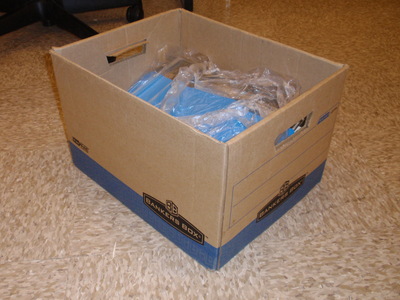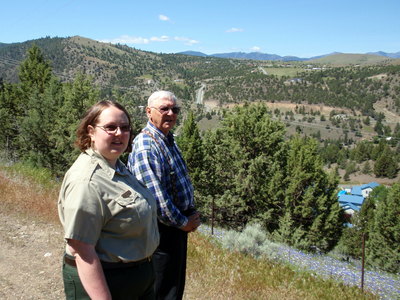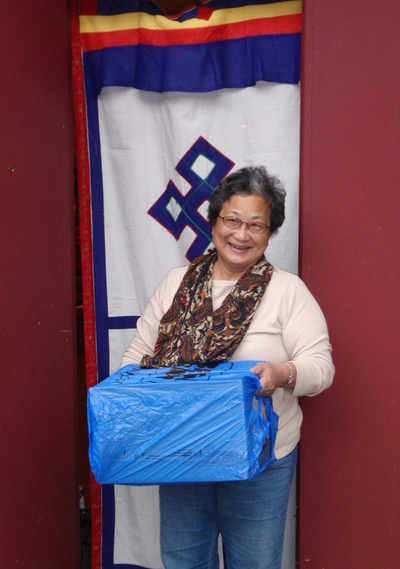The Story of the Documents: An “Unfinished Journey”
In 2010, public radio regional reporter Tom Banse investigated the story behind the disinterment documents donated to public radio’s Northwest News Network.
Banse first interviewed Dennis Smith along with Christina Sweet, Oregon State Parks curator in John Day at the Kam Wah Chung historic site to learn more about the lives of Chinese immigrants in Oregon during the mid-nineteenth century. He then gained insight regarding the tradition of disinterment through conversations with Priscilla Wegars, an archaeologist and historian in Moscow, Idaho, as well as Rebecca Liu of the Chinese Consolidated Benevolent Association. He concluded his report by speaking with documentary filmmaker Ivy Lin, who researched the subject herself for her film Come Together Home: Death. Disinterment. Reburial.
“Unfinished Journey: Historic Documents Trace Immigrants' Remains Long Trip Home”
Tom Banse, 2010-07-15
Transcript of Radio Broadcast
Duration: 7 mintutes
[00:00 min]
Our anonymous source delivered a simple file box. It smelled of dust... decades-old dust. The jumble of papers inside is yellowed and crinkly. [Sound: unpacking of papers] But looking through it, I find names, dates and places. I quickly discover the names belong to dead Chinese immigrant workers. Most passed away early in the last century. The records point to a mystery. It begins with graves, empty graves. The bodies are gone.
Sound: (John Day outdoor ambience)
The document trail leads me to a Chinese cemetery in John Day, Oregon. Dennis Smith remembers snooping around the little cemetery when he was kid growing up in this small eastern Oregon mountain town.
Dennis Smith: "I remember the papers with the little holes. Little rolls of paper and they had holes."
Those paper strips were likely a traditional Chinese grave offering.
Tom: Who do we think was buried here?
Dennis Smith: "The workers. The miners. And of course, they were domestics. They did whatever work they could find."
Christina Sweet: "We don't know who most of the Chinese were who were out here. They're pretty lost to history. By the height, by around 1880, about a thousand or 1500 are the estimates -- a huge population out here."
That's Oregon State Parks curator Christina Sweet. She works in John Day at the Kam Wah Chung historic site. It's a unique state park that highlights the fact that a century ago Chinatowns sprung up all over the Northwest. They rose around mining boomtowns like this and also at coastal fish canneries. But now?
Tom: "When the two of you look around, what do you see now of a Chinese cemetery and the signs of a population of a thousand?"
Christina Sweet: "Nothing is here. It's all developed into houses and roads. The landscape is changed... The gravesites aren't here. So they kind of get lost to history and to people's memory, which makes these records pretty exciting."
Sound: (distant truck passing; car door opening)
On scene narration in Baker City: "From John Day, I get in the car and drive about an hour and half northeast to Baker City, where I am now. Baker City's Chinese Cemetery, while a little bit overgrown, is preserved. The remarkable thing is here in front of me I can see pits or depressions in the ground where 62 years ago just about all of the remaining Chinese immigrants buried here were dug up and sent back to China. The papers I have in my lap here have the names of the last 22 to go. They include Lock Ching, Jung Jee, Lock Sin, Lee Guay, Fong Wing and others."
But why? Why go through the trouble of digging up all these graves? That question takes me to Priscilla Wegars in Moscow, Idaho. She's an archaeologist and historian. Wegars tells me in Chinese popular religion the ancestors' spirits protect the living.
[02:45 min]
Priscilla Wegars: "There is a symbiotic relationship between the spirit of the deceased person and the living family members. The family has to come and burn spiritual tributes to them in the form of paper -- like paper money, paper cars, today, paper cell phones - burn these and then these will go to heaven where the deceased will be able to make use of them."
This explains the empty graves. The early waves of Chinese immigrants to this country typically traveled alone, without family. They hoped to return home with pockets full of money. But some of them died here with no one around to visit their graves.
Priscilla Wegars: "If you're here and you're buried here, then your family cannot do these obeisances because they need a grave to do it at where your spirit resides."
Wegars has found examples from all over the West of Chinese benevolent societies systematically digging up remains and sending them home. The documents I received detail two of these campaigns. In 1928, six hundred fifteen remains made the journey. Then again, after World War II another 559 sets of bones were collected. In Portland, Rebecca Liu found records of the fundraising campaign for that second effort.
Rebecca Liu: "It's a request sent out to every city, every Chinese community in Oregon. So everybody (contributes) a dollar, or five dollars, ten dollars, three dollar. They are all willing to chip in, particularly the businesses."
The Chinese Consolidated Benevolent Association organized this. Liu teaches Chinese language classes for that group, which still exists today. Their 1949 shipment would be the last large-scale exhumation of this type in Northwest.
Rebecca Liu: "Sending somebody's remains back home we consider it is a good deed. You carry it as good karma. That's what the American people say, karma."
Unfortunately, somewhere along the way the enterprise must have picked up some bad karma too. Legal records I reviewed include a case of the wrong body being dug up. Also, a shipping agent was accused of embezzling what was supposed to be the cargo payment to deliver the bones from Portland to Hong Kong. But the biggest problem was that in mid-1949 China was sinking into the throes of civil war.
[05:00 min]
So whatever happened to that final shipment of bones? Documentary filmmaker Ivy Lin wondered the same thing. She asked around in Portland's Chinatown.
Ivy Lin: "A couple elders, they said we just don't know what happened to these bones. And then a couple of them said they were probably dumped into the ocean. Hah! I'm not Buddhist, but being Chinese, I know that's really bad karma. You don't just do that with strangers' bones, let alone hundreds of boxes of bones. I was like, that can't be true."
Last year, Lin flew to Hong Kong to see if she could pick up the trail of the pioneer immigrants. Her quest turned into a movie titled "Come Together Home."
Sound: (movie soundtrack) "I burst into tears... I said, I found them.'" cicadas chirp
Our papers show the carefully crated boxes of bones were addressed to a charity hospital in Hong Kong. We have a receipt letter proving it got there. But then the Northwest immigrants' bones were marooned.
Ivy Lin: "By the time they arrived in Hong Kong, the civil war already started in China. So the Communist Party in China closed the borders."
China would remain a closed country for decades. That caused overseas Chinese to pretty much stop the practice of exhuming immigrant graves and sending the remains home. Lin says the wandering souls shipped from Oregon in 1949 are still warehoused in Hong Kong to this day.
Ivy Lin: "They just left home for so long that a lot of them I believe they lost contact with them."
Sound: (swell up moody soundtrack music in brief pause)
That's where the document trail ends, but I found one more twist. Several academics have detected a reversal in the flow of bones across the Pacific. In the case of Ivy Lin, her father passed away in Taipei ten years ago.
Ivy Lin: "We have talked about moving my dad's ashes over to the U.S."
Ivy Lin is among several history buffs who called the historical records we received "a treasure box." We plan to deliver the documents to an archive in Oregon to make them available for further study. I'm Tom Banse in Portland.
[end 07:00 min]
Original Source: Link to KPLU site with the Report
Tom Banse Radio Broadcast (7 minutes)




